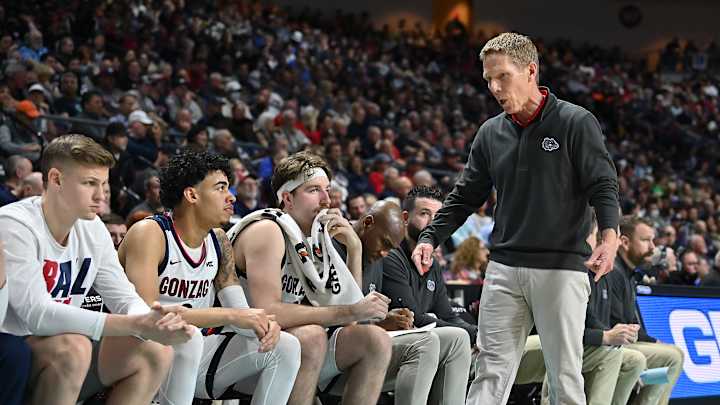Small-ball or run it back? Analyzing potential starting fives for Gonzaga

It was a zero-to-hero type of offseason for the Zags, who are considered national title contenders once again with a revamped roster of familiar and new faces alike. Striking out on highly touted recruits, along with the uncertain futures of Drew Timme, Rasir Bolton and Julian Strawther had many fans feeling uneasy throughout spring. Then, in less than a week’s time, GU got its national player of the year candidate and his costars back to join Efton Reid and Malachi Smith, two additions via the transfer portal, to build yet another star-studded rotation full of depth at every position.
Because even then, there was plenty of young and promising talent on the roster already. Nolan Hickman and Hunter Sallis are primed for big sophomore seasons, and a healthy Dominick Harris completes an exciting backcourt trio for the future. In the frontcourt, Anton Watson headlines a group featuring Braden Huff, Ben Gregg and Kaden Perry, who’s status remains uncertain coming off a leg injury.
It's quite the team, no doubt, but there’s one question unanswered — who cracks the starting five for Mark Few?
There’s plenty of options to go with given the versatility on-hand, but here’s two lineups that should be considered ahead of the regular season:
The small-ball lineup: Hickman, Bolton, Smith, Strawther, Timme
Trotting out three guards at once maximizes the amount of shooting and playmaking in the rotation, something Gonzaga has grown fond of in recent years. Though it gives up size on the perimeter, having four ballhandlers provides valuable floor-spacing for penetration and more room for Timme to operate down low near the basket. It’s a high-powered, pro-style approach that opens the door for more fastbreaks and creativity in half-court sets.
After landing Smith this offseason, it seemed like him and Hickman would compete for the starting point guard spot. The latter has more experience in Gonzaga’s system and projects as a prototypical playmaker in the offense — someone who doesn’t need the ball to be effective on offense. Smith, the reigning SoCon Player of the Year, is a three-level scorer who’s coming off a near-20 ppg season with the fifth-highest usage percentage in the conference.
Both bring something different to the table with their respective styles of play, so why not just start both? Primary ballhandling duties could be shared of course, and with Bolton and Strawther spotting up outside, there’s a lot of area to set up pick-and-rolls with Timme. Smith did a lot of damage in the midrange last season too, as nearly one-third of his shot attempts came from that area.
There wouldn’t be any shortage of 3-point shooting between Bolton (46% last season), Smith (40.7%) and Strawther (36.5%). And if the NBA Draft combine meant anything, Timme might show off an expanded range to some capacity this season.
Up front, Strawther could thrive in the “Corey Kispert” role — an athletic spot-up shooter that makes up for his slight lack of size with versatility. Having Strawther in the fold forces opposing defenses to either play their traditional power forwards on the perimeter or play smaller wings at the position to combat the small-ball affect. Should he continue his ascension in the offense, though, the mismatch should be in his favor most of the time, especially in the WCC.
Run-it-back lineup: Hickman, Bolton, Strawther, Watson, Timme
Should Few opt for the size (and continuity), moving Strawther to the “3” and inserting Watson down low next to Timme makes the most sense. Those two have worked well together on both ends of the floor, and while neither is a true stretch-big, there will be plenty of spacing for them to operate on the perimeter or run the patent Gonzaga high-low set. Watson can also work as another pick-and-roll option for Hickman and Bolton.
On paper, it doesn’t look as flashy as the aforementioned small-ball lineup, but the defensive versatility is where this rotation shines.
After missing a majority of his freshman season, Watson has been a defensive anchor for the Zags over the last two seasons. The full-court press thrived with him in the “roamer” role, intercepting and deflecting passes like a free safety in football. Only Andrew Nembhard averaged more steals per game last season, but Watson’s steal rate with him on the floor was tops on the team.
Given more opportunity, Watson could put together a defensive player of the-year-type season. His career 88.4 defensive rating (an estimate of points allowed per 100 possessions) is the best in the WCC over that three-year span, along with his plus-5.1 defensive blox/plus minus. Last year’s counting numbers would have looked better if not for Holmgren but make no mistake — Watson is in line to be the true anchor now, whether he comes off the bench or starts.
Strawther fits well on the perimeter given his combination of agility and size at 6-foot-7, while Hickman and Bolton are hustle defenders who love to take away their matchup’s air space. Timme is an improved defender at the rim as well, even if he isn’t a true shot-blocker, he can get vertical and alter shots with his length.
The Verdict
It’s hard not to like the firepower of the small-ball lineup with three guards on the floor at once. As great as Watson is defensively, opposing defenses would have a harder time matching up against multiple three-level scorers as opposed to a lineup with three forwards. And with four quality shooters on the floor, teams would think twice about double-teaming Timme down low.
And let’s not forget, the Zags were one of the best up-tempo offenses last season. This four-ballhandler lineup gives them the best chance at continuing that trend into 2022-23.
Few will experiment with a couple of rotations to start the season as always, and adjustments will be made depending on the opponent. In reality, there’s no wrong answer to the question — the Zags are loaded once again.
